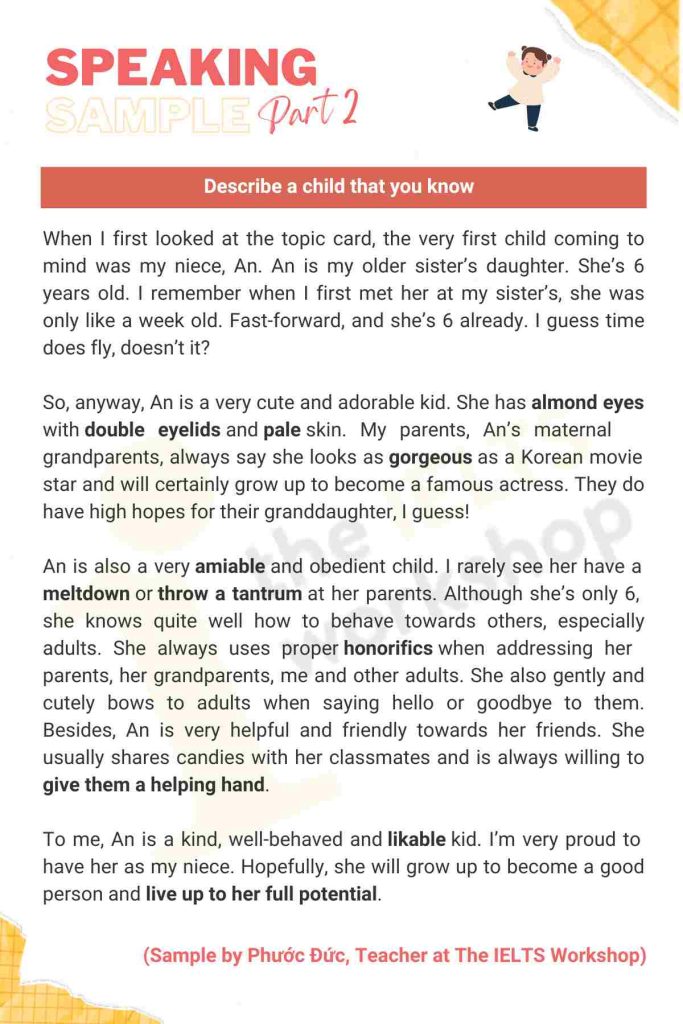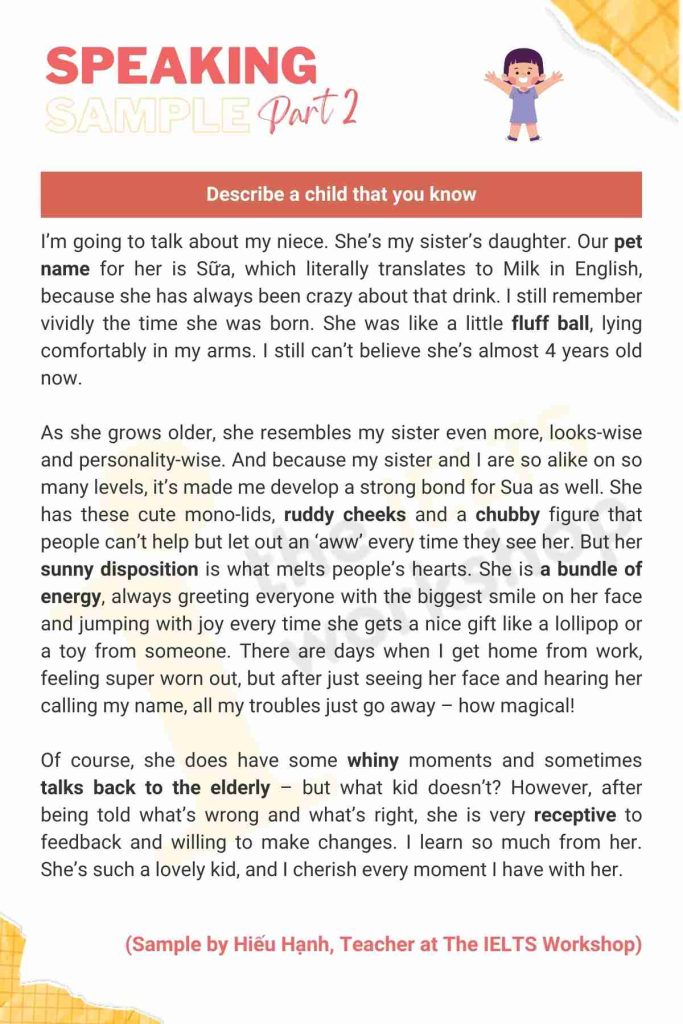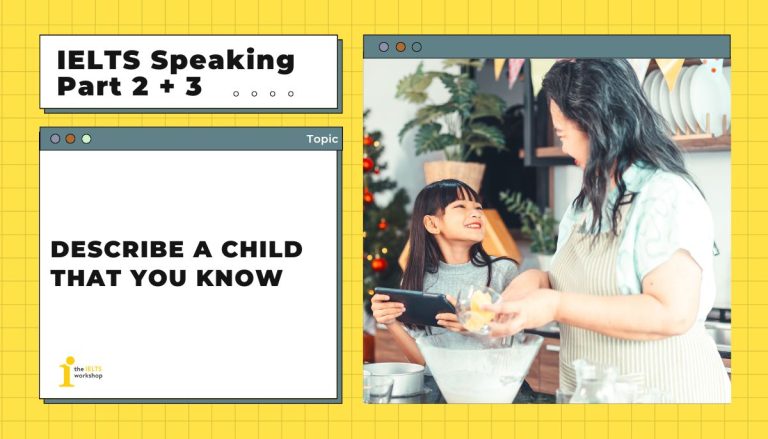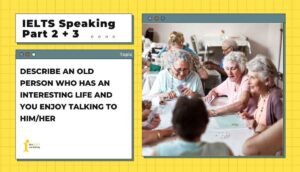Đến với chuyên mục giải đề kỳ này, thầy Phước Đức và cô Hiếu Hạnh của The IELTS Workshop sẽ hướng dẫn bạn trả lời topic “Describe a child that you know” trong IELTS Speaking Part 2. Cùng tham khảo sample, từ vựng và một vài cách diễn đạt ghi điểm trong phần thi IELTS Speaking nhé.
Part 2: Describe a child that you know
Describe a child that you know
You should say:
Who this child is and how often you see him or her
How old this child is
What he or she is like
And explain what you feel about this child.
Dưới đây là bài mẫu cho topic “Describe a child that you know”.
1. Bài mẫu (Sample)
Sample 1:

Sample 2:

2. Từ vựng (Vocabulary)
Sample 1:
- Almond / Almond-shaped eyes: mắt có hình quả hạnh nhân
- Double eyelids: mắt hai mí
- Pale (adj): (nói về da) sáng màu hoặc nhợt nhạt
- Gorgeous (adj): very beautiful and attractive
- Amiable = Likable (adj): dễ chịu; dễ có thiện cảm và thân thiện
- Meltdown (n): một cơn mất kiểm soát
- Have/Throw a (temper) tantrum: có một cơn giận dỗi
- Honorific (n): kính ngữ
- Give someone a helping hand (idiom): giúp ai đó một tay
- Live up to one’s full potential: phát huy hết tiềm năng của bản thân
Sample 2:
- Pet name: tên ở nhà/tên gọi thân mật
- Fluff ball: cục bông
- Ruddy cheeks: má đỏ hây hây
- Chubby: mũm mĩm
- Sunny disposition: tính tình vui vẻ
- A bundle of energy: nhiều năng lượng
- Whiny: mè nheo
- Talk back to sb: cãi lại ai
- Receptive: sẵn sàng lắng nghe, tiếp thu
Part 3
How much time do children spend with their parents in your country? Do you think that is enough?
How important do you think spending time together is for the relationships between parents and children Why?
Have relationships between parents and children changed in recent years? Why do you think that is?
What are the most popular free-time activities with children today?
Do you think the free-time activities children do today are good for their health? Why is that?
How do you think children’s activities will change in the future? Will this be a positive change?
1. How much time do children spend with their parents in your country? Do you think that is enough?
Sample 1: I think it varies from family to family. Some children get to spend lots of time playing, talking and hanging out with their parents, while others can barely share a meal with them. In my country’s culture, family bonding is of great importance, so many parents try to spend as much time connecting and bonding with their children as possible, which is a good thing. However, not all parents can afford to spend a decent amount of time with their kids, probably because of their tight work schedules or the fact that they have numerous other responsibilities as adults. For those super busy parents, I don’t think they’re spending sufficient time with their children, and this may compromise their relationship with their own sons and daughters.
- Family bonding: sự gắn kết trong gia đình
- Bond (+ with sb) (v): gắn kết (với ai đó)
- Tight work schedule: lịch trình làm việc dày đặc
- Sufficient (adj): enough
- Compromise (v): làm tổn hại; ảnh hưởng xấu đến
Sample 2: I believe the amount of time children spend with their parents in Vietnam has dramatically decreased over the years. Modern-day parents, under economic pressure, have to devote a huge amount of time at work and therefore, spend less time with their kids. Children, on the other hand, absorbed in their mobile phones, are less inclined to communicate with their mothers and fathers.
2. How important do you think spending time together is for the relationships between parents and children? Why?
Sample 1: I believe spending time together is crucial for parent-child bonding. Firstly, it helps build a strong emotional bond. When parents and children do something together, such as playing sports, having meals, or just talking, they create shared experiences and memories that strengthen their connection. Spending quality time with their parents also makes it easier for children to open up to them about their own thoughts and feelings, which is not often the case when children and parents are not as close. In addition, bonding with parents has a positive impact on a child’s emotional development. Parents can take time to teach their children essential life skills and model good behaviors. For instance, parents can infuse values such as compassion, self-esteem and self-discipline through their interactions with their children.
- Crucial (adj): extremely important
- Bond (n): mối liên kết; mối quan hệ
- Open up (to sb) (phrasal verb): mở lòng (với ai đó)
- Model (v): làm mẫu
- Infuse (v): truyền (cái gì cho ai đó)
- Compassion (n): lòng trắc ẩn
- Self-esteem (n): lòng tự trọng
- Self-discipline (n): kỷ luật tự giác
Sample 2: It is pivotal in fostering a strong parent-child bond. These interactions allow parents to offer guidance and support to their kids when they are in need. Children, on the other hand, also benefit from the tried-and-true advice given by their caregivers. Being in constant contact with their parents also creates long-lasting memories, which contribute to a child’s happy childhood and play an important role in their developmental stage.
3. Have relationships between parents and children changed in recent years? Why do you think that is?
Sample 1: Absolutely! The way I see it, relationships between parents and children have become more open and equal. In the past, parents always seemed to be the ones making decisions, and children were expected to obey without question. These days, parents are more likely to ask for their children’s opinions and involve them in decision-making processes. In my opinion, this shift has promoted mutual respect, collaboration and deeper emotional ties within families.
- Decision-making processes: những quy trình đưa ra quyết định
- Tie (n) (usually plural): một mối liên kết mạnh mẽ
Sample 2: I believe they have changed radically, and this can be largely attributed to the proliferation of social media platforms and the advent of technological devices. These days, both parties are so immersed in their mobile phones and laptops that they spend less time with each other. Another reason for this is due to the increased level of pressure. Both parents and children now usually suffer from a heavy workload at work and school, which take up their time for day-to-day communication.
4. What are the most popular free-time activities with children today?
Sample 1: When it comes to children’s favorite leisure pursuits, the first one I can think of is playing video games. There is no doubt that a lot of children engage in this activity nowadays, whether on consoles, computers or mobile devices. Another prevalent pastime is watching on-demand videos on streaming platforms like YouTube and Netflix. These days, there is plenty of online content that is appealing and suitable for children, so many of them spend hours watching it every day.
- Leisure pursuit: hoạt động giải trí
- Engage in (phrasal verb): tham gia
- Prevalent (adj): common
- Pastime (n): hobby
- On-demand (adj): theo yêu cầu
- Streaming platform: nền tảng phát trực tuyến
- Appealing (adj): hấp dẫn và thú vị
Sample 2: Although traditional outdoor play is still favored by some youngsters, I do think digital entertainment has taken center stage. Most children now spend hours on end surfing the web and playing video games. However, there has been a newfound interest in structured activities like sports or arts class. For example, pickleball is a sport that has recently gained a lot of traction among the youth due to its interesting format.
5. Do you think the free-time activities children do today are good for their health? Why is that?
Sample 1: I think so. Hobbies like playing sports and doing exercise help them keep fit and get in shape. Creative activities like drawing and playing musical instruments boost their imagination and creativity, which contributes to their emotional well-being. However, excessive screen time from pursuits like playing video games and using social media can adversely impact both the physical and psychological health of children. Therefore, it’s important for adults to help children keep those hobbies in check.
- Get in shape (idiom): có được vóc dáng cân đối
- Keep sth in check (idiom): giữ cho cái gì đó trong tầm kiểm soát
Sample 2: 50/50. On the one hand, digital devices offer certain cognitive benefits for children as they provide valuable and insightful information on different fields. However, spending an excessive amount of time looking at the screen can lead to a sedentary lifestyle, causing numerous health issues. This has been evidenced by the fact that many contemporary children, from a very early age, have suffered from severe cases of diabetes and obesity.
6. How do you think children’s activities will change in the future? Will this be a positive change?
Sample 1: Well, I assume that in the future, children’s activities may change with technological advances. There could be a wider application of digital learning tools, artificial intelligence and virtual reality, affecting children’s learning and recreational activities. For example, students may consult AI writing tools when doing homework, and they may prefer VR games over traditional video games. In my view, this shift could offer new opportunities for learning and creativity but will also require careful management to ensure children’s health and well-being.
- Technological advances: những tiến bộ về công nghệ
- Artificial intelligence: trí tuệ nhân tạo
- Virtual reality: thực tế ảo
- Recreational (adj): thuộc về giải trí
Sample 2: I do think that there will be a positive transformation in the landscape of children’s activities in the upcoming years, as they will be more interested in physical activities. These days, due to the endorsement of healthy lifestyles by many fitness influencers on social media, young people have become more health-conscious and therefore, decided to follow suit. They are sticking to a stricter regimen of exercise and diet, and outdoor activities such as archery, basketball or pickleball are becoming much more prevalent. So, I believe there would be a positive shift in children’s activities in the future.
Bài mẫu bởi thầy Phước Đức và cô Hiếu Hạnh – Giáo viên The IELTS Workshop
Xem thêm: Bài mẫu IELTS Speaking Part 2+3 – Topic: Helping a child
Trên đây là bài mẫu cho topic: Describe a child that you know. Các bạn có thể tham khảo các Tổng hợp bài mẫu IELTS Speaking khác của The IELTS Workshop để có thể nâng cao kỹ năng Speaking của mình.
Ngoài ra, tham khảo khoá học Senior của The IELTS Workshop để có thể tìm hiểu thêm nhiều chiến lược làm bài khác của Speaking nhé.









